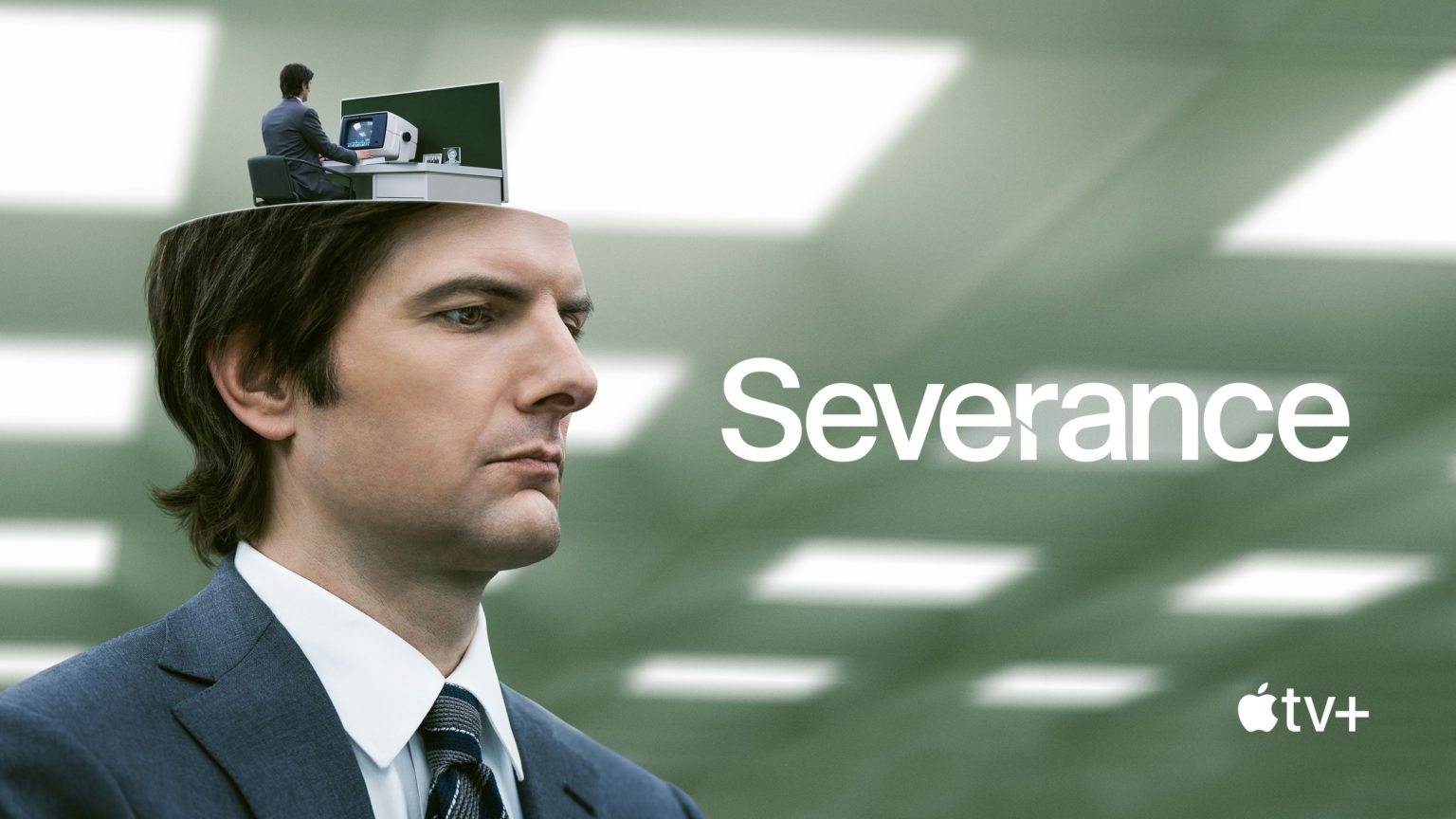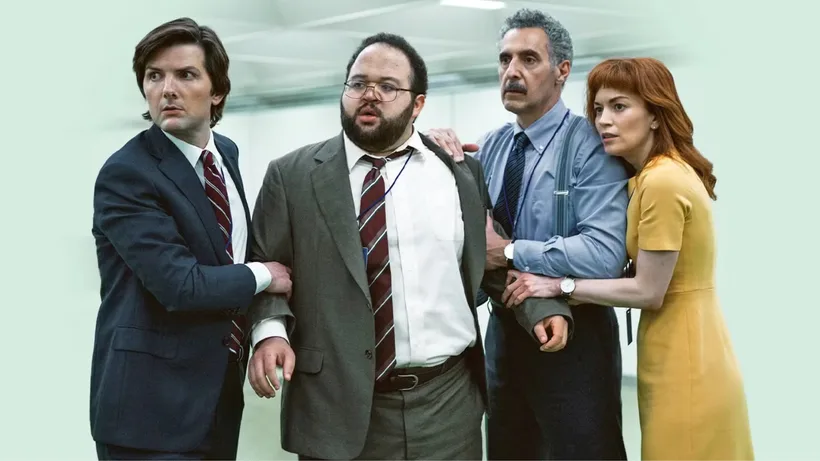28 Mar Deep Dive: Inside the Soundscape of Severance
Apple TV+’s Severance captured viewers’ imaginations with its twisted portrayal of corporate culture and identity. At the heart of this unsettling world is composer Theodore Shapiro’s subtle yet powerful musical score, which weaves together atmospheric soundscapes and melodic motifs to heighten the show’s tension and mystery. We take a deep dive into the show’s soundtrack to uncover how it reinforces Severance’s distinctive tone and narrative.

Severance and Sound Design
Set in the sterile halls of Lumen Industries, Severance follows employees who undergo a procedure that surgically splits their consciousness into two halves – “innie” (work self) and “outie” (personal self). Each episode blends psychological unease with dark humor and wistful moments of empathy. The soundtrack serves as the backbone for the series’ emotional landscape: it shapes viewer perceptions of the eerie, fluorescent-lit labyrinth of Lumen’s offices and underscores the quiet desperation pulsing through each character’s life.
Theodore Shapiro’s name may ring a bell for those familiar with film and TV scoring. He has composed for features like Tropic Thunder and The Secret Life of Walter Mitty. In Severance, Shapiro breaks away from overt, flashy scores. Instead, he creates sonic textures that can float, ruminate, or unnerve – perfectly mirroring the show’s themes of blurred identity and psychological suspense.

The Musical Framework of Severance
Minimalistic Melodies:
A recurring hallmark of the show’s score is restrained, repeated piano motifs. These simple phrases become claustrophobic by design, reiterating the monotony and tight control of Lumen’s corporate world. The piano lines loop and linger, reflecting characters’ cyclical office routines and the reality from which they can’t escape.
Ambient Soundscapes and Electronics:
Dissonant electronics or droning synthesizers underscore key scenes, particularly within the labyrinth of windowless hallways. The near-silent intensity of moments in Lumen’s corridors can suddenly shift into haunting soundscapes to remind us that something is deeply unnatural about the environment. The mechanical hums and subtle beeps in the background mimic corporate machinery, subtly blending with musical elements to further blur the line between environment and score.
Tension Through Silence:
Severance cleverly uses silence to build suspense. In several scenes, the absence of music is almost louder than any orchestration, focusing attention on the characters’ microexpressions or ominous background noises. This technique of using stillness to sharpen tension makes the music’s eventual entrance all the more powerful.
Subtle Orchestral Layers:
Though much of the soundtrack maintains an electronic or minimalist character, certain emotional beats incorporate sweeping strings or layered orchestral chords. These passages often surface during personal revelations – when an innie feels a stirring of memory from the outside world, or an outie senses something isn’t quite right. The orchestral swelling becomes a release valve for pent-up emotion, highlighting the show’s delicate exploration of human connection.
Key Themes and Motifs
Repetition and Routine:
The repeated rhythmic patterns in the score mirror the daily routines at Lumen: filing reports, taking breaks in the eerie break room, or walking the same florescent-lit hallways. This sense of routine traps the viewer inside the corporate hamster wheel, leaving them to share in the employees’ uneasy repetition.
Duality of Identity:
The show’s overarching theme of a severed identity seeps into the music through layered instrumentation. Shapiro frequently pairs a single piano line with a distant, echoing tone, suggesting two voices forever close yet never truly merging. This motif symbolizes an innie and outie coexisting in parallel worlds – sometimes harmonizing, sometimes clashing.
Subconscious Unrest:
Subtle distortions or disharmonic shifts in the soundtrack hint that beneath Lumen’s orderly exterior lies something ominous. These moments often float under the surface – like a gradual off-tune drone – building a nagging sense that something isn’t right. The music becomes a representation of the secrets lurking behind each keystroke.
How the Soundtrack Effects the Viewing Experience
Emotional Anchoring:
In a setting that is intentionally bland and emotionally cold, the music provides viewers with the emotional cues they need to feel connected to the characters. A gentle melodic line here, a brooding undercurrent there – these details guide us through shifts in tone and help us empathize with characters who appear socially distant on the surface.
Narrative Cohesion:
The soundtrack connects seemingly disconnected story elements by maintaining a consistent sonic identity. Whether we’re watching Mark S shuffle through Lumen’s corridors or stepping back into Mark Scout, the music ties both worlds together. This ensures that even when the show jumps between drastically different settings, we still feel the same unnerving tension humming beneath the narrative.
Building Anticipation and Mystery:
Slow builds, lingering chords, and ominous swells keep viewers on edge. Whether it’s the murky gloom of Lumon’s severed floors or a chance discovery that threatens to unravel the status quo, the music layers each revelation in an undercurrent of dread, holding our attention and drawing us deeper into the story.

Why the Score Stands Out
What makes Theodore Shapiro’s composition especially noteworthy is its refusal to overshadow the show. Many modern thrillers or dramas rely on large orchestral gestures, but Severance instead leans on near-silence and precise ambient tones. This pared-back style magnifies every subtly discordant note, ensuring that the music constantly shapes the tension that defines the viewer’s experience.
While each cue may sound simple in isolation, the score’s power lies in repetition and atmosphere. Punctuating scenes with minimalistic motifs is a creative (and risky) move, as it demands the perfect balance of tension and melody. The result: a soundscape that grips the viewer from the first eerie chord to the show’s haunting final moments.
Severance defies easy categorization as both a dark workplace satire and a psychological labyrinth. Theodore Shapiro’s score echoes this duality, weaving sparse piano motifs, spectral synthesizers, and brief orchestral expansions into an otherworldly tapestry. By masking overt emotional sweeps behind carefully crafted minimalism, the music intensifies the uneasy atmosphere while still allowing glimmers of genuine emotion to shine through.
In many ways, the score for Severance feels like an additional character – present, watchful, and subtly guiding us through the show’s labyrinth of secrets. It’s an artful blend of the familiar and the uncanny, leaving listeners in a state of tension and fascination. If you haven’t paid attention to the soundtrack on your first watch of the show, it’s worth a watch focusing on the music as it relates to the emotion of the scene. You’ll discover new details with each replay – further proof of how this deeply considered score elevates Severance from a merely intriguing premise into one of television’s most compelling, immersive experiences.
If you’re looking for tracks that echo the moody minimalism and psychological tension found in Severance, we have curated a collection that fuses ambient soundscapes, subtle orchestral layers, and minimalist piano motifs – perfect for projects that demand both introspection and creeping suspense. These pieces channel the same restrained intensity of Theodore Shapiro’s approach while remaining fully licensable for film, TV, and digital media. Listen to the collection here.


